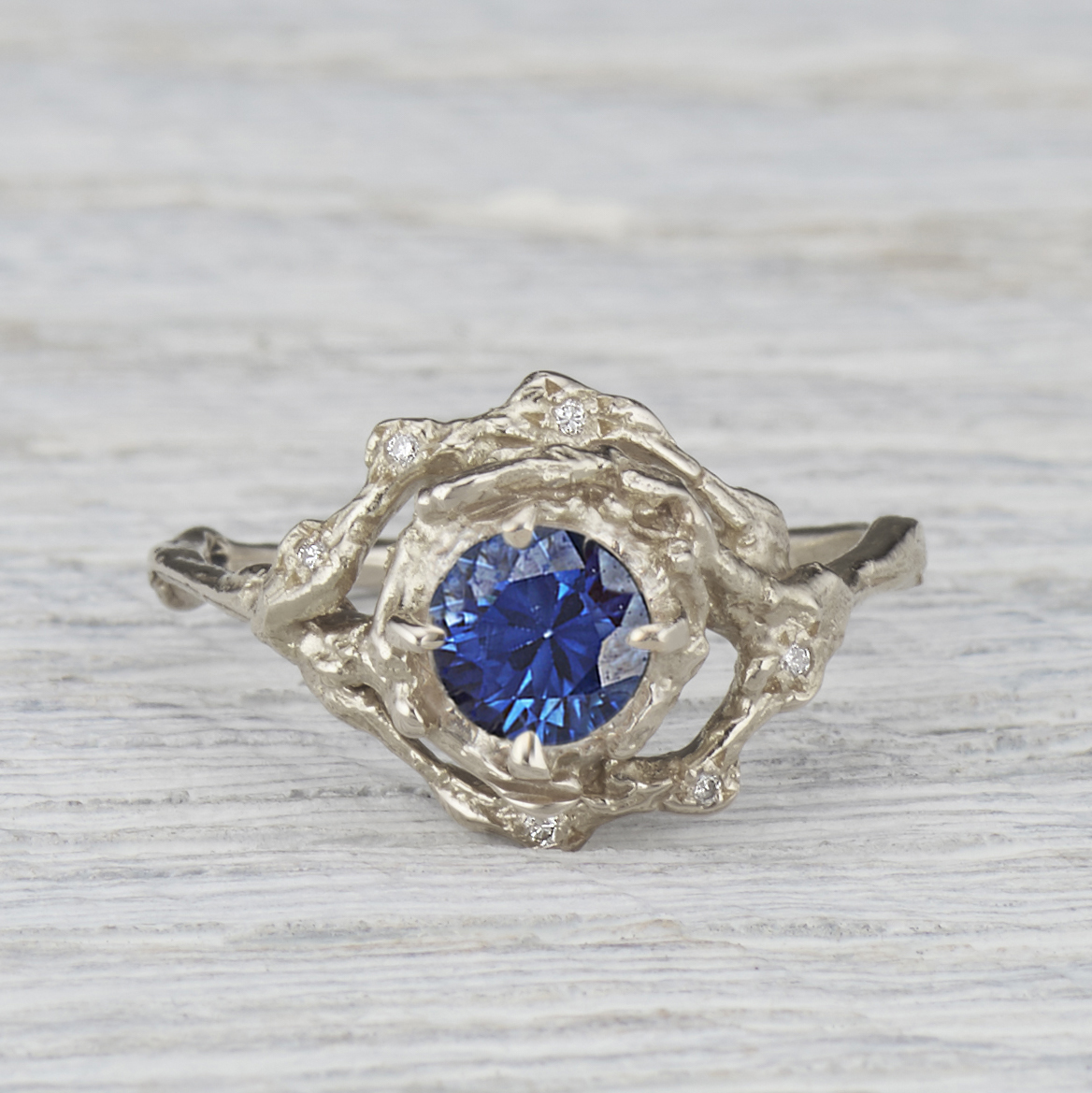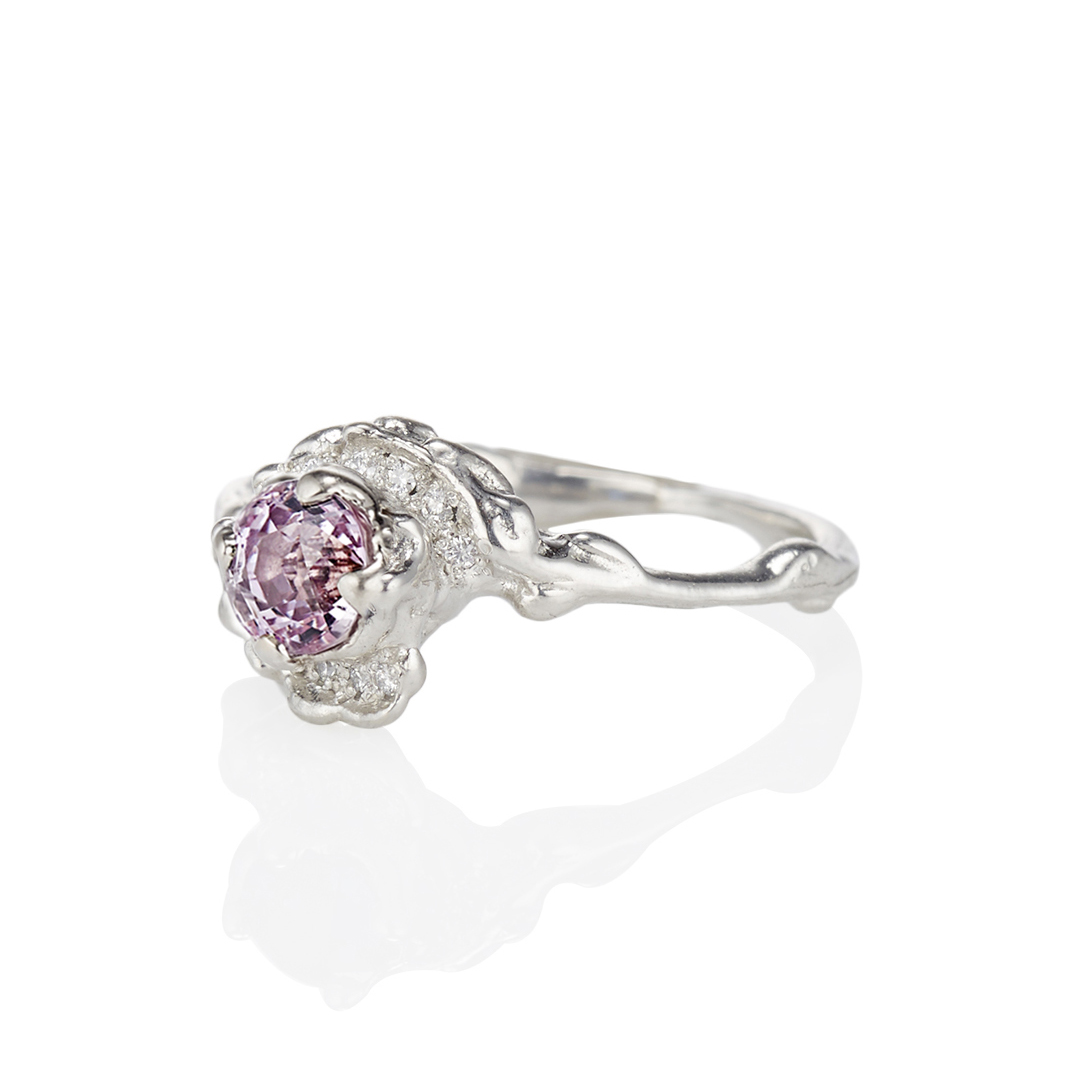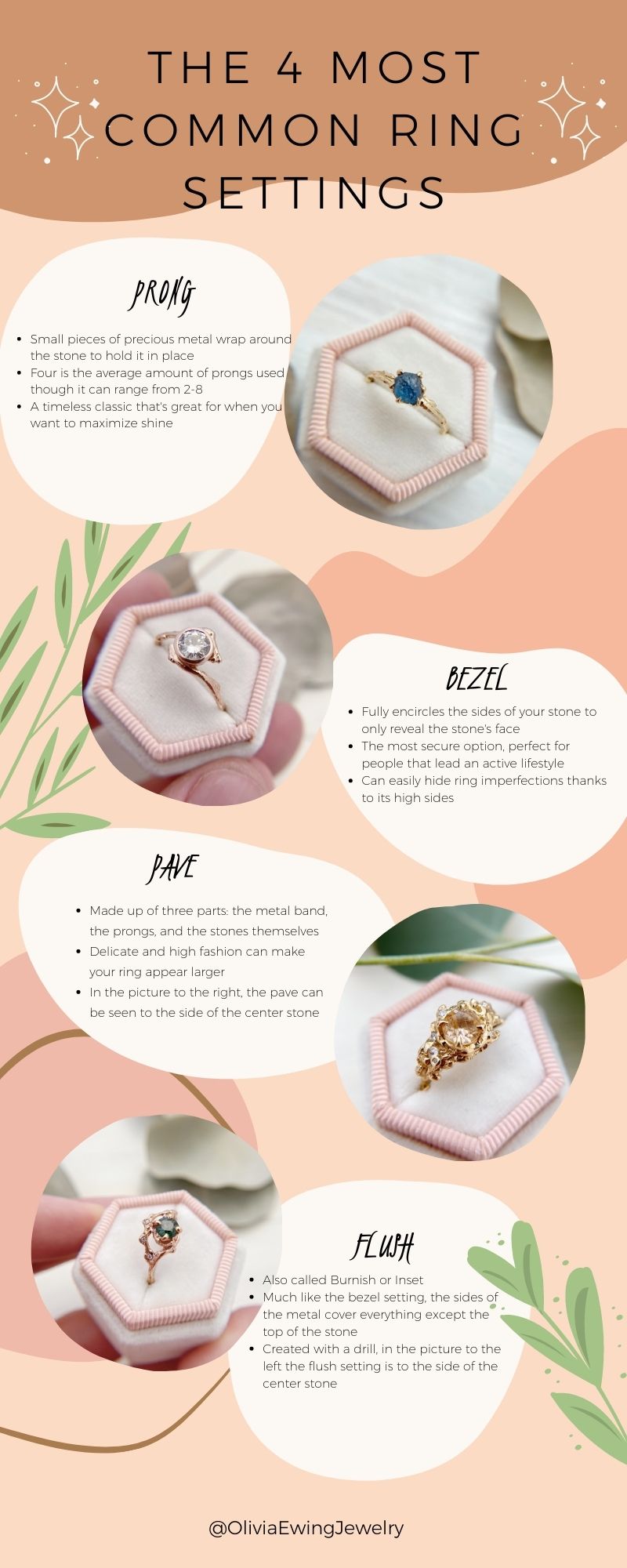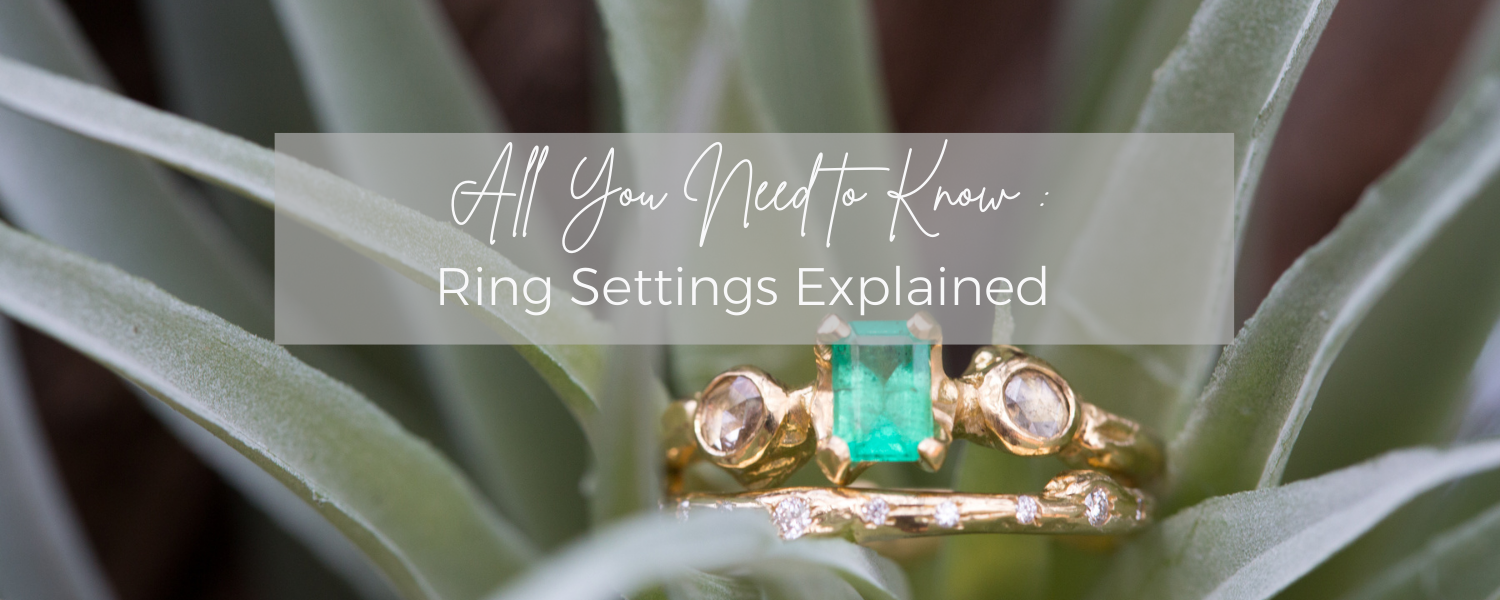Posted by Olivia Ewing on 11th Jul 2022
View Post
WHAT IS A RING SETTING AND WHY DOES IT MATTER?
Your engagement ring setting can make or break the look and feel of your ring. It gives it personality, helps make it a part of you, and provides stylish security for your diamond or engagement gemstone. Yet, despite the fact that the ring setting is one of the most integral components of the ring, it is often overlooked and not considered while engagement ring shopping.
We’ve compiled a handy guide to keep in mind when considering the different ring settings and which one may best be suited for you. So keep reading, to learn all about engagement ring settings!
WHAT IS A RING SETTING?

Let’s first get into what exactly a ring setting is and isn’t.
A ring setting is not the band surrounding the stone—that’s called the shank. The shank is the band surrounding the stone and holding it in place, but that's not always what people mean when they talk about "the setting." In fact, sometimes they mean the entire piece of jewelry—the shank, the stone, and everything else that makes up your ring.
A ring setting is the part of a ring that holds the stone in place. It can be made of many different materials, including gold, platinum, silver, or even plastic. Ring settings can be very simple or very ornate, depending on your taste and budget.
THE MOST COMMON DIAMOND RING SETTINGS
There are quite a few ring settings to choose from and it can be difficult to determine where to even start looking. Below, we’ve highlighted a few popular settings from Olivia Ewing Jewelry that have been proven time and time again to dazzle and delight while securely holding your stone in place.
PRONG
The prong setting is the most common way to set precious stones. A prong is a short piece of metal that holds the stone in place. It can be made of gold, platinum, or some other precious metal, or it can be made of a synthetic material like plastic or stainless steel. The stone is placed on top of the prongs and held in place by pressure from the prongs reaching around and holding it from its table.
The prongs are usually set in a row to parallel each other, but they don't have to be. The number of prongs depends on how big you want your stone to look when it's finished. The closer together they are, the smaller each individual prong will look; the farther apart they are spaced, the larger each individual prong will appear.
Rings can be set with between 2 and 8 prongs, though 4 prongs are the most common amount.
PROS OF PRONG SET ENGAGEMENT RINGS
- Prongs can easily be applied to any gemstone shape to securely hold it in place
- Because prongs elevate your stone, your diamond or gemstone can look larger than its actual carat weight
- A prong setting shows the most surface area of any gemstone, allowing maximum fire, brilliance, and scintillation to shine through
CONS OF PRONG SET ENGAGEMENT RINGS
- A prong setting can easily snag and tear clothing or other fabrics
- Offer little protection due to its minimalist design
SHOP PRONG SET RINGS
BEZEL
A bezel setting is the second most popular engagement ring setting after prongs. Unlike a prong setting that holds your stone in place through a short piece of metal, a bezel setting fully encircles the sides of the stone to ensure the gemstone's security.
The bezel itself is usually made out of precious metal and can feature intricate details like designs or engravings.
PROS OF BEZEL SET ENGAGEMENT RINGS
- A bezel setting offers the most security for your gemstone out of any other setting and can help prevent scratching, chipping, or breaking thanks to its high sides that meet the top of your stone
- While most commonly used to set round brilliant diamonds, a skilled jeweler is able to set any gemstone shape and type into a bezel. This is particularly useful if the gemstone or diamond shape of your choice is considered more delicate and prone to scratching
- The sides of the bezel are able to masterfully hide any imperfections within your stone. All that people will be able to see is the sparkling table!
CONS OF BEZEL SET ENGAGEMENT RINGS
- Because the metal wraps completely around the side and bottom of the stone, it may appear smaller than its actual carat weight and prevent light from escaping through the sides and bottom. As a result, it may seem slightly less sparkly than if your stone was set in a prong setting
- A higher amount of expertise and metal is needed to effectively create a bezel setting. As such, you can expect to pay more for a gemstone set in a bezel
SHOP BEZEL SET ENGAGEMENT RINGS
PAVÉ
A pavé setting is a ring setting that's made up of individual stones, rather than one solid piece. It allows you to customize the look of your ring by adding or subtracting stones or even changing the kinds of stones in your setting.
A pavé setting is made up of three main parts: the metal band that holds everything together, prongs that hold each stone in place on top of the band, and the stones themselves. The prongs are typically attached to the inner surface of the band—they'll be visible if you look at your ring from the inside out, but not if you look at it from the outside in.
PROS OF PAVÉ SET ENGAGEMENT RINGS
- The much-beloved halo style of ring, where a pavé setting is utilized to surround the center stone with smaller gems, is a perfect example of the added bling of your ring that makes your center stone seem larger
- A pavé setting works with any combination of gemstones, metals, or wedding bands. The opportunity to mix and match is endless
CONS OF PAVÉ SET ENGAGEMENT RINGS
- Pavé set rings tend to be more delicate than other settings due to the smallness of the prongs that hold the stones in place. If you are an active person you may need to often remove your ring before going about your activities
BURNISH/ FLUSH
A burnish setting (also called flush or inset setting), is much like a bezel setting as the diamond or gemstone is only visible from the surface and the sides are covered. The difference between the two is that the burnish setting is created by drilling holes into the precious metal as opposed to wrapping the metal around the gem.
A burnish setting is most appropriate for smaller stones and can create a constellation like effect.
PROS OF BURNISH/FLUSH/ INSET SET ENGAGEMENT RINGS
- Burnish set rings are very secure and can be worn during rigorous activities without fear of losing a stone
- Burnish set rings are incredibly easy to clean thanks to the lack of crevices that would otherwise house dirt and grime
CONS OF BURNISH/FLUSH SET ENGAGEMENT RINGS
- If you’re looking for a large stone it will not be able to sit flush within the metal. This type of setting is suited for more minimalistic rings and gems
SHOP BURNISH SET RINGS
WHAT ENGAGEMENT RING SETTING WILL MAKE MY DIAMOND LOOK BIGGER?

The best engagement ring settings to make your diamond (or gemstone) look bigger are those that use prongs to hold the diamond in place.
This is because the prong setting allows the gemstone to be seen from all sides, unlike the bezel or flush setting, which cover all of the stone except its table.
You also want to make sure that when you choose a setting for your engagement ring, you choose one with prongs that are large enough to support your diamond but not so large that they draw attention away from it.
Finally, if size is your focus, consider utilizing a combo prong and pavé diamond setting. The pavé draws the attention to the center stone while the prong exposes the sides of the diamond to reflect light back and out from every facet.
HOW DO I CHOOSE AN ENGAGEMENT RING SETTING

Choosing an engagement ring setting can be a daunting task. There are so many options, and each one has its own benefits. Fortunately, if you take the time to consider the following you can pretty much guarantee your satisfaction with any decision you make.
One of the most important factors to consider when choosing a ring setting is understanding your activity level and the amount of stress your ring may have to endure. For example, if you are a rock climber and frequently find yourself using your fingers to help propel you up a cliff, a delicate setting like pavé or prong may not be the best choice.
Ask yourself how often you use your hands? Would you be comfortable repeatedly taking off your ring for safekeeping?
If you are planning on wearing your engagement ring daily, we recommend that you choose a setting that has some form of security (like flush or bezel) to prevent the stone from easily falling off.
Next, think about what kind of style you're going after. Are you looking for something traditional? If so prong is the way to go. Modern? Consider bezel! Do you want a lot of bling? Or do you prefer something more subtle? This will help narrow down your search for the perfect setting.
Finally, consider the metal you would prefer your setting to be. While it’s not alway customizable sometimes, and when it is, this little detail can make all the difference.
While gem settings may seem insignificant, they can play a major role in the overall beauty of your engagement ring. They add style and flair that you can't get with a typical loose gem. Therefore, just as you would take time to select the stone and metal for your engagement ring, don't overlook your setting!

Meet the Author: Olivia Ewing



